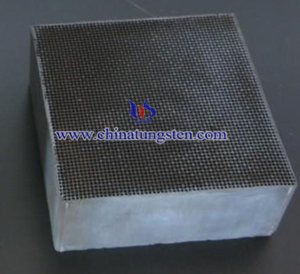Tungsten Trioxide Denitration Catalyst Alkali Metal Poisoning
- Details
- Category: Tungsten Information
- Published on Monday, 18 April 2016 17:15
 Tungsten trioxide denitration catalyst will be affected by a lot of dust in the flue gas and toxic substances during operation, and tends to be inactivated. Alkali metal poisoning is mainly due to the alkali metal can directly react with the active site, thus making the catalyst deactivation; the mechanism is that an alkali metal can react with the V-OH acid sites on the catalyst surface and generate V-OM, this will cause ammonia adsorption capacity of the catalyst dropped, thereby the activity of ammonia in the SCR denitration system reduced; moreover, the generated particles may also deposit on the surface of the catalyst or part holes, which will hinder the nitric oxide and ammonia spread to the inner of catalyst and finally cause catalyst deactivation. It is generally believed that alkali metal poisoning (Ca, Mg) is mainly physical poisoning, which the Ca and Mg may deposit on the surface of the catalyst pore to cause blocking, ammonia and NO contacting with the active catalyst sites obstructed, finally resulting in catalyst deactivation.
Tungsten trioxide denitration catalyst will be affected by a lot of dust in the flue gas and toxic substances during operation, and tends to be inactivated. Alkali metal poisoning is mainly due to the alkali metal can directly react with the active site, thus making the catalyst deactivation; the mechanism is that an alkali metal can react with the V-OH acid sites on the catalyst surface and generate V-OM, this will cause ammonia adsorption capacity of the catalyst dropped, thereby the activity of ammonia in the SCR denitration system reduced; moreover, the generated particles may also deposit on the surface of the catalyst or part holes, which will hinder the nitric oxide and ammonia spread to the inner of catalyst and finally cause catalyst deactivation. It is generally believed that alkali metal poisoning (Ca, Mg) is mainly physical poisoning, which the Ca and Mg may deposit on the surface of the catalyst pore to cause blocking, ammonia and NO contacting with the active catalyst sites obstructed, finally resulting in catalyst deactivation.
Experimental results have showed that:
1. Ca and Mg oxides affect catalyst activity
The NO conversion rate of tungsten trioxide catalyst is 95.84% at 300°C, the activity decreased obviously after Ca and Mg oxides added; when the molar ratios of Ca, Mg and V equals to 3.0, its activity respectively decreased to 82.0% and 71.24%.
2. Ca, Mg affect catalyst characterization
The incorporation of Ca and Mg oxides has not effect on vanadium pentoxide distributed on the carrier of tungsten trioxide denitration catalyst, that is to say vanadium pentoxide is still distributed in the state of no definite patterns or highly dispersed at the surface of the titanium dioxide. Furthermore, CaO and MgO also disperse in the amorphous or highly state at the catalyst surface and do not form the crystallization of CaO and MgO. With the increasing concentration of Ca and Mg, the amount of B Acid sites reduced, thus resulting in the weakened of ammonia adsorbing ability, the final running of SCR denitration impacted.
| Tungsten Oxide Supplier: Chinatungsten Online www.tungsten-oxide.com | Tel.: 86 592 5129696; Fax: 86 592 5129797;Email:sales@chinatungsten.com |
| Tungsten News & Prices, 3G Version: http://3g.chinatungsten.com | Molybdenum News & Molybdenum Price: http://news.molybdenum.com.cn |